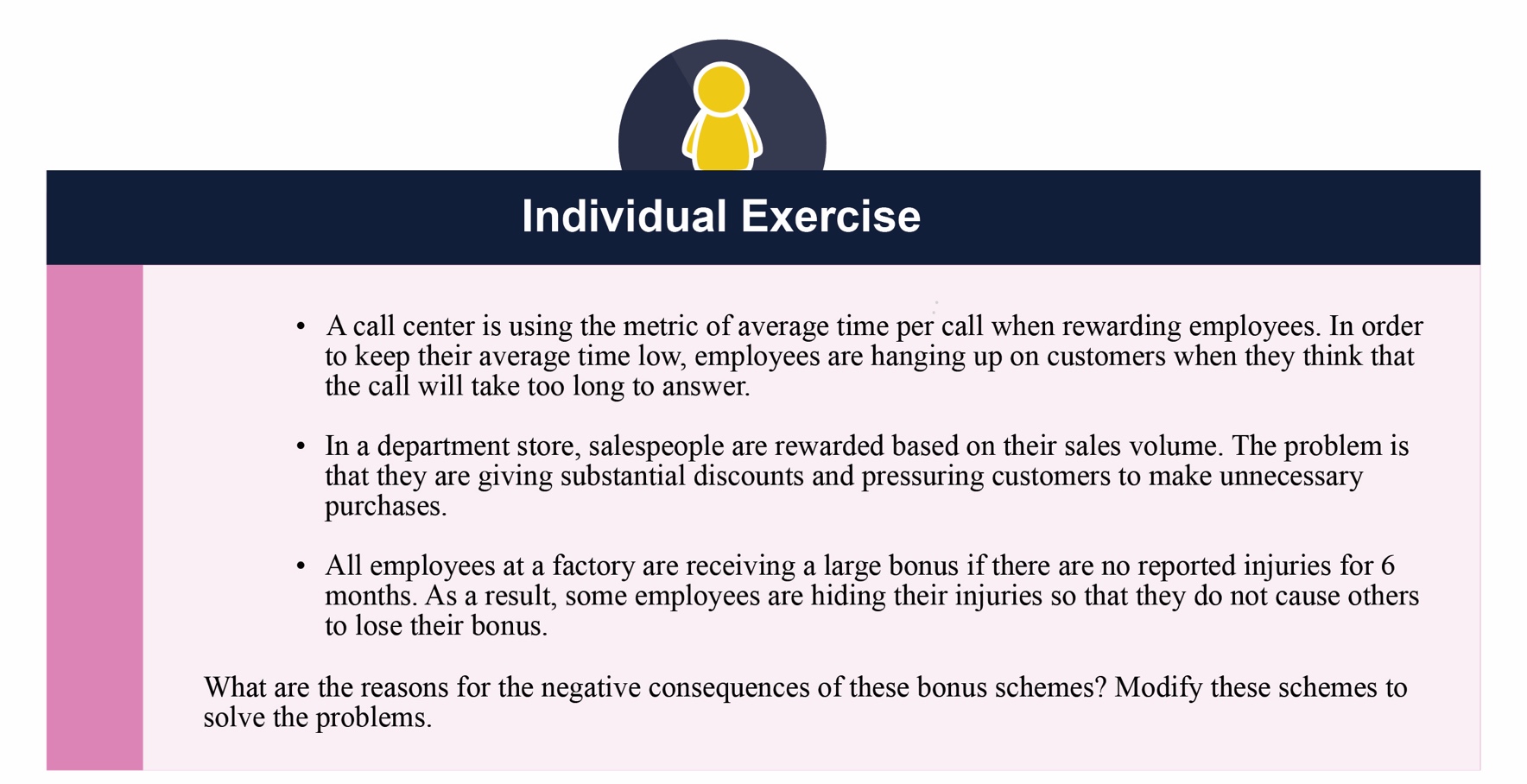Chapter 6: Designing a Motivating Work Environment
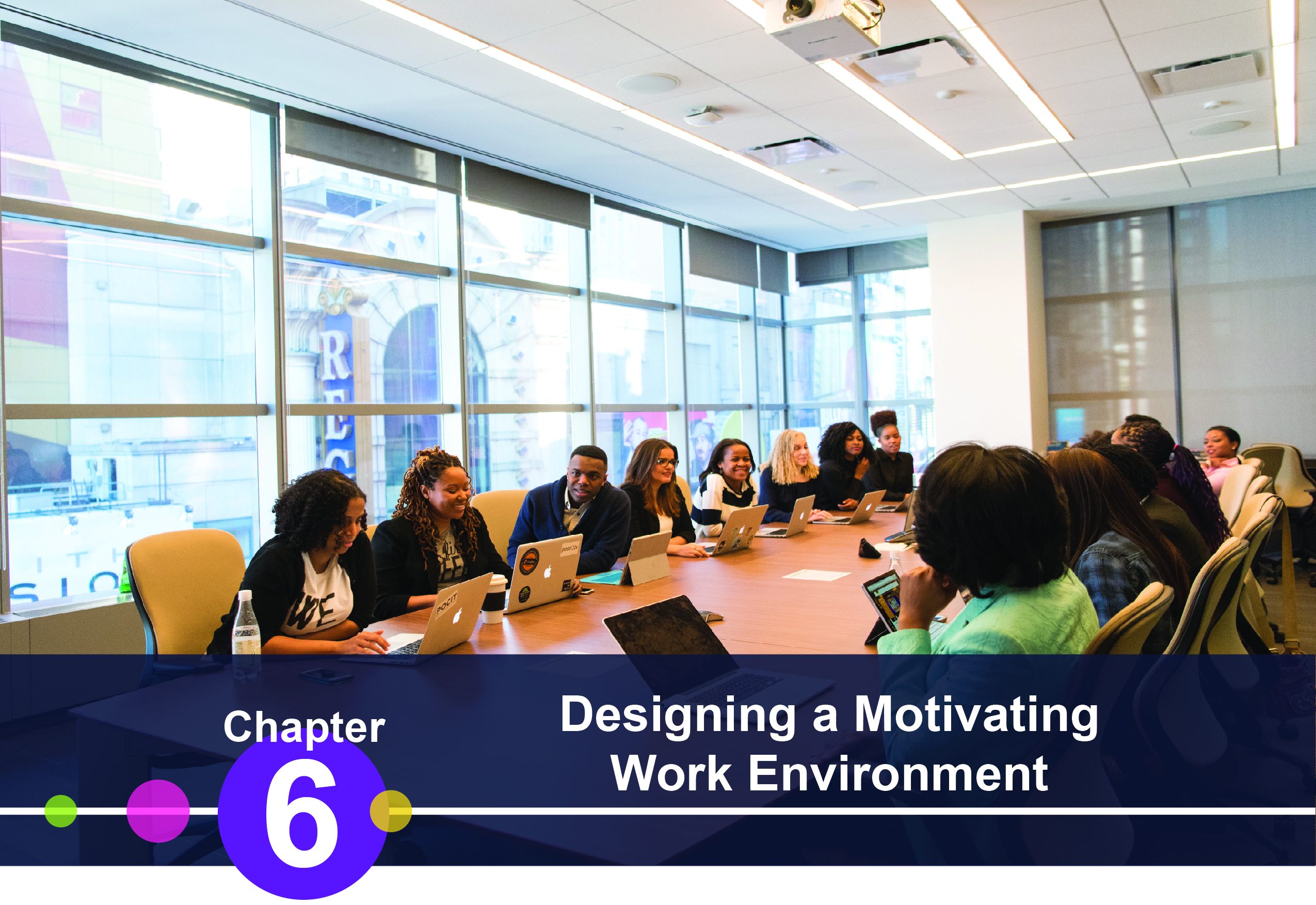
Learning Objectives
After reading this chapter, you should be able to do the following:
- Understand how to increase the motivating potential of a job.
- Understand why goals should be SMART.
- Set SMART goals.
- Describe individual-, team-, and organization-based incentives that can be used to motivate the workforce.
What are the tools companies can use to ensure a motivated workforce? Shopify in Canada seems to have found two very useful tools to motivate its workforce: a job design incorporating empowerment, and a reward system that aligns company performance with employee rewards. In this chapter, we will cover the basic tools organizations can use to motivate workers. The tools that will be described are based on motivation principles such as expectancy theory, reinforcement theory, and need-based theories. Specifically, we cover motivating employees through job design, goal setting, performance feedback, and reward systems.
Video: The puzzle of motivation by Dan Pink: https://www.youtube.com/watch?v=rrkrvAUbU9Y
6.1 Motivating Employees: The Case of Canada’s Shopify

Shopify is a Canadian e-commerce company based in Ottawa, Ontario. Shopify offers services to online retailers “including payments, marketing, shipping and customer engagement tools to simplify the process of running an online store for small merchants.” (McLeod, 2018). Shopify has been identified as one of Canada’s top employers.
What differentiates Spotify from other Canadian companies? Watch the video below and see what aspects you can pick out that make this a really motivating place for employees:
Video: Glassdoor: Shopify #1 Best Place to Work in Canada 2017: https://www.youtube.com/watch?v=jeYiNo0fjfM
6.2 Motivating Employees Through Job Design
Importance of Job Design
Many of us assume the most important motivator at work is pay. Yet, studies point to a different factor as the major influence over worker motivation—job design. How a job is designed has a major impact on employee motivation, job satisfaction, commitment to an organization, absenteeism, and turnover.
The question of how to properly design jobs so that employees are more productive and more satisfied has received attention from managers and researchers since the beginning of the 20th century. We will review major approaches to job design below.
Rotation, Job Enlargement, and Enrichment
One of the early alternatives to job specialization was job rotation. Job rotation involves moving employees from job to job at regular intervals. When employees periodically move to different jobs, the boring aspects of a job can be relieved. For example, Maids International Inc, a company that provides cleaning services to households and businesses, utilizes job rotation so that maids cleaning the kitchen in one house would clean the bedroom in a different one (Denton, 1994). Using this technique, among others, the company is able to reduce its turnover level. In a supermarket study, cashiers were rotated to work in different departments. As a result of the rotation, employees’ stress levels were reduced, as measured by their blood pressure. Moreover, they experienced less pain in their neck and shoulders (Rissen et al., 2002).
Job enlargement refers to expanding the tasks performed by employees to add more variety. By giving employees several different tasks to be performed, as opposed to limiting their activities to a small number of tasks, organizations hope to reduce boredom and monotony as well as utilize human resources more effectively. Job enlargement may have similar benefits to job rotation, because it may also involve teaching employees multiple tasks. Research indicates that when jobs are enlarged, employees view themselves as being capable of performing a broader set of tasks (Parker, 1998). There is some evidence that job enlargement is beneficial, because it is positively related to employee satisfaction and higher quality customer services, and it increases the chances of catching mistakes (Campion & McClelland, 1991).
Job enrichment is a job redesign technique that allows workers more control over how they perform their own tasks. This approach allows employees to take on more responsibility. As an alternative to job specialization, companies using job enrichment may experience positive outcomes, such as reduced turnover, increased productivity, and reduced absences (McEvoy & Cascio, 1985; Locke, Sirota, & Wolfson, 1976). This may be because employees who have the authority and responsibility over their work can be more efficient, eliminate unnecessary tasks, take shortcuts, and increase their overall performance.
Job Characteristics Model
The job characteristics model is one of the most influential attempts to design jobs with increased motivational properties (Hackman & Oldham, 1975). Proposed by Hackman and Oldham, the model describes five core job dimensions leading to three critical psychological states, resulting in work-related outcomes.

Skill variety refers to the extent to which the job requires a person to utilize multiple high-level skills. A car wash employee whose job consists of directing customers into the automated car wash demonstrates low levels of skill variety, whereas a car wash employee who acts as a cashier, maintains carwash equipment, and manages the inventory of chemicals demonstrates high skill variety.
Task identity refers to the degree to which a person is in charge of completing an identifiable piece of work from start to finish. A web designer who designs parts of a website will have low task identity, because the work blends in with other web designers’ work; in the end it will be hard for any one person to claim responsibility for the final output. The web master who designs an entire website will have high task identity.
Task significance refers to whether a person’s job substantially affects other people’s work, health, or well-being. A janitor who cleans the floors at an office building may find the job low in significance, thinking it is not a very important job. However, janitors cleaning the floors at a hospital may see their role as essential in helping patients get better. When they feel that their tasks are significant, employees tend to feel that they are making an impact on their environment, and their feelings of self-worth are boosted (Grant, 2008).
Autonomy is the degree to which a person has the freedom to decide how to perform his or her tasks. As an example, an instructor who is required to follow a predetermined textbook, covering a given list of topics using a specified list of classroom activities, has low autonomy. On the other hand, an instructor who is free to choose the textbook, design the course content, and use any relevant materials when delivering lectures has higher levels of autonomy. As more employees are working from home since the COVID-19 pandemic, autonomy is something that has gained even more importance to employers.
Feedback refers to the degree to which people learn how effective they are being at work. Feedback at work may come from other people, such as supervisors, peers, subordinates, and customers, or it may come from the job itself. A salesperson who gives presentations to potential clients but is not informed of the clients’ decisions, has low feedback at work. If this person receives notification that a sale was made based on the presentation, feedback will be high.
According to the job characteristics model, the presence of these five core job dimensions leads employees to experience three psychological states: they view their work as meaningful, they feel responsible for the outcomes, and they acquire knowledge of results. These three psychological states in turn are related to positive outcomes such as overall job satisfaction, internal motivation, higher performance, and lower absenteeism and turnover (Brass, 1985; Humphrey, Nahrgang, & Morgeson, 2007; Johns, Xie, & Fang, 1992; Renn & Vandenberg, 1995). Research shows that out of these three psychological states, experienced meaningfulness is the most important for employee attitudes and behaviours, and it is the key mechanism through which the five core job dimensions operate.
Note that the five job characteristics are not objective features of a job. Two employees working in the same job may have very different perceptions regarding how much skill variety, task identity, task significance, autonomy, or feedback the job affords. In other words, motivating potential is in the eye of the beholder. This is both good and bad news. The bad news is that even though a manager may design a job that is supposed to motivate employees, some employees may not find the job to be motivational. The good news is that sometimes it is possible to increase employee motivation by helping employees change their perspective on the job. For example, employees laying bricks at a construction site may feel their jobs are low in significance, but by pointing out that they are building a home for others, their perceptions about their job may be changed.
In addition to these key factors impacting psychological outcomes among employees, the COVID-19 pandemic has raised unique considerations around employee engagement and motivation. Andrlic, Priyashantha, and De Alwis (2023) found that companies who engaged in competency building related to autonomy, demonstrating employee empathy, and directing expectations helped in job engagement among their employees during the Covid-19 pandemic.
Empowerment
One of the contemporary approaches to motivating employees through job design is empowerment. The concept of empowerment extends the idea of autonomy. Empowerment may be defined as the removal of conditions that make a person powerless (Conger & Kanugo, 1988). The idea behind empowerment is that employees have the ability to make decisions and perform their jobs effectively if management removes certain barriers. Thus, instead of dictating roles, companies should create an environment where employees thrive, feel motivated, and have discretion to make decisions about the content and context of their jobs. Employees who feel empowered believe that their work is meaningful. They tend to feel that they are capable of performing their jobs effectively, have the ability to influence how the company operates, and can perform their jobs in any way they see fit, without close supervision and other interference. These liberties enable employees to feel powerful (Spreitzer, 1995; Thomas & Velthouse, 1990). In cases of very high levels of empowerment, employees decide what tasks to perform and how to perform them, in a sense managing themselves.
Empowerment of employees tends to be beneficial for organizations, because it is related to outcomes such as employee innovativeness, managerial effectiveness, employee commitment to the organization, customer satisfaction, job performance, and behaviours that benefit the company and other employees (Ahearne, Mathieu, & Rapp, 2005; Alge et al., 2006; Chen et al., 2007; Liden, Wayne, & Sparrowe, 2000; Spreitzer, 1995). At the same time, empowerment may not necessarily be suitable for all employees. Those individuals with low growth strength or low achievement needs may not benefit as strongly from empowerment. Moreover, the idea of empowerment is not always easy to implement, because some managers may feel threatened when subordinates are empowered. If employees do not feel ready for empowerment, they may also worry about the increased responsibility and accountability. Therefore, preparing employees for empowerment by carefully selecting and training them is important to the success of empowerment interventions.
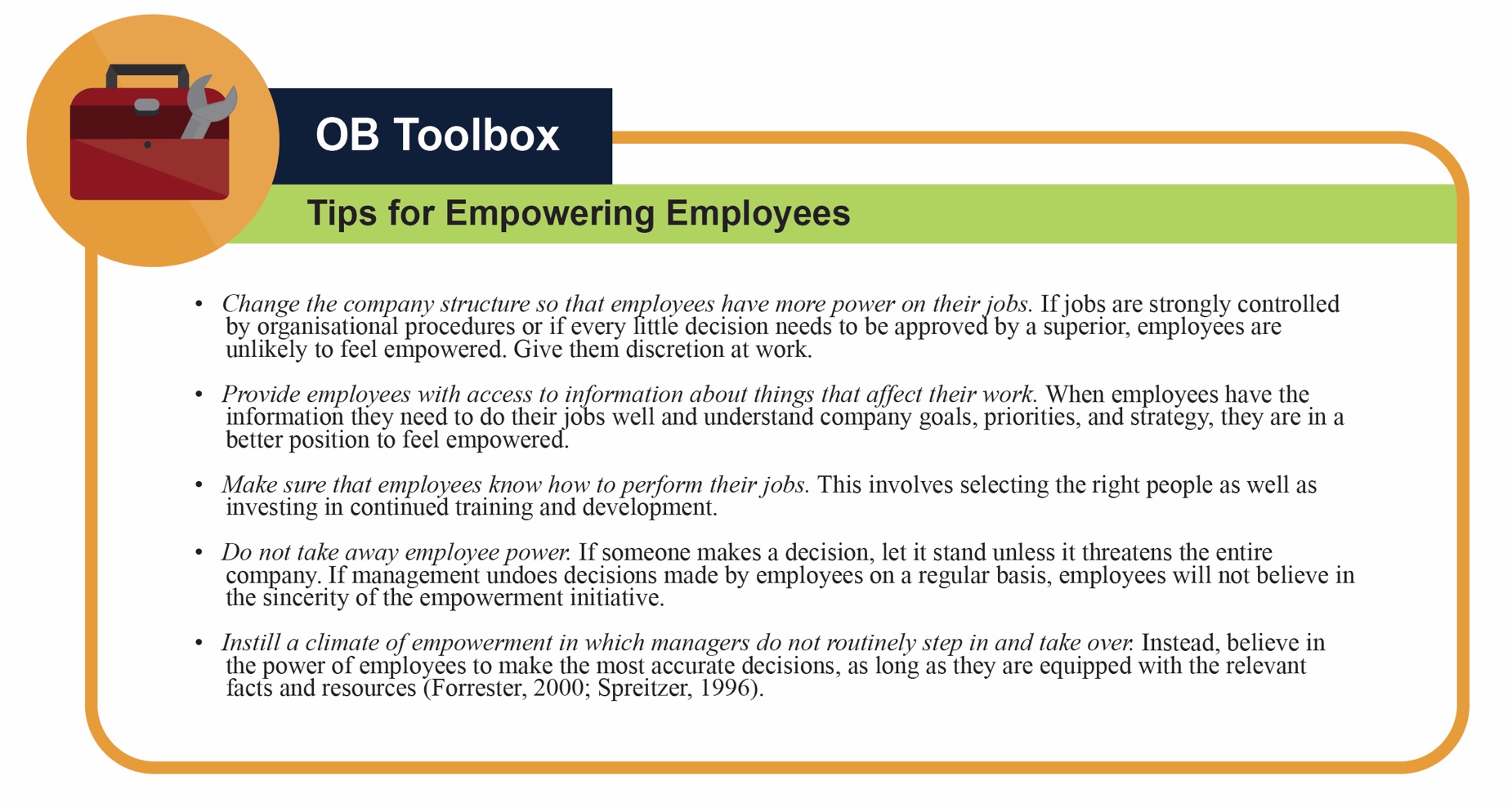

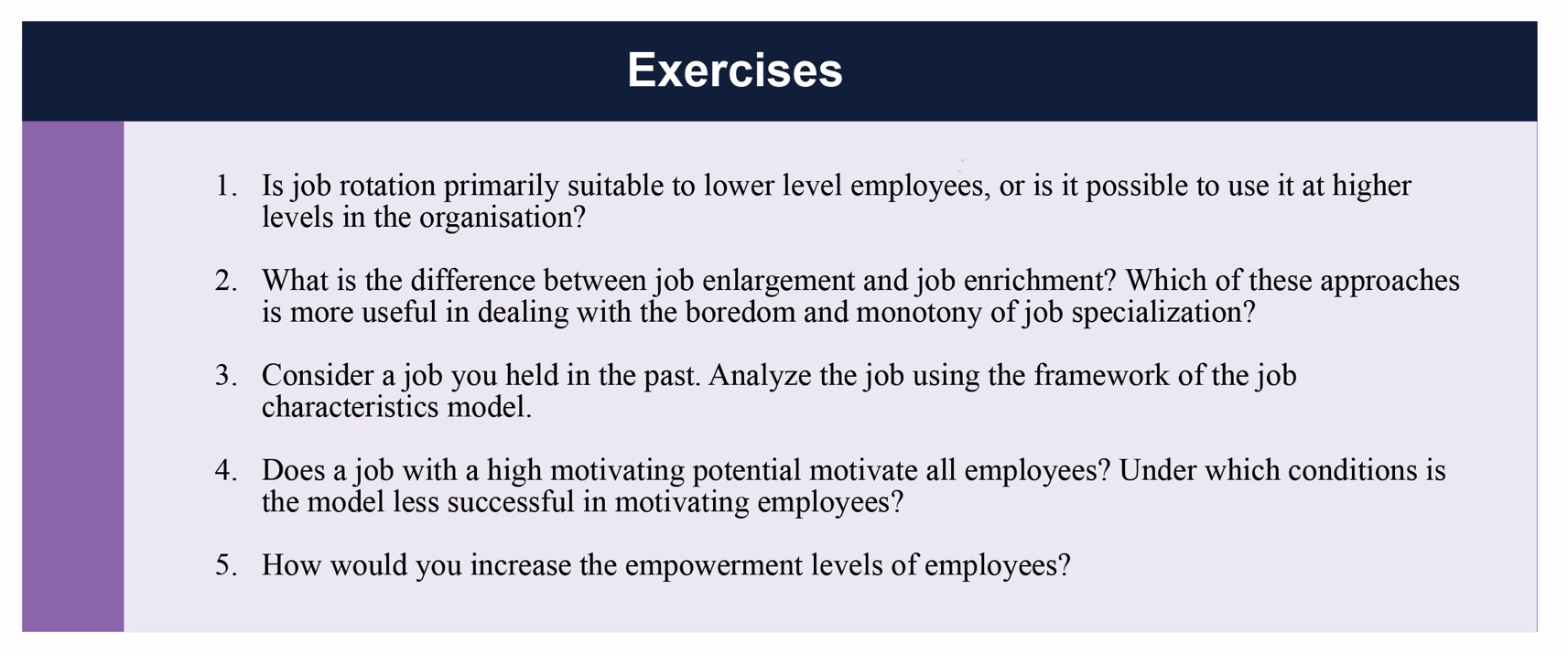
6.3 Motivating Employees Through Goal Setting
Goal-Setting Theory
Goal-setting theory (Locke & Latham, 1990) is one of the most influential and practical theories of motivation. In fact, in a survey of organizational behaviour scholars, it has been rated as the most important (out of 73 theories) (Miner, 2003). The theory has been supported in over 1,000 studies with employees ranging from blue-collar workers to research-and-development employees, and there is strong support that setting goals is related to performance improvements (Ivancevich & McMahon, 1982; Latham & Locke, 2006; Umstot, Bell, & Mitchell, 1976). According to one estimate, goal setting improves performance at least 10%–25% (Pritchard et al., 1988). Based on this evidence, thousands of companies around the world are using goal setting in some form, including Coca Cola Company, PricewaterhouseCoopers International Ltd, Nike Inc, Intel Corporation, and Microsoft Corporation, to name a few.
Setting SMART Goals
Are you motivated simply because you have set a goal? The mere presence of a goal does not motivate individuals. Think about New Year’s resolutions that you made but failed to keep. Maybe you decided that you should lose some weight but then never put a concrete plan in action. Maybe you decided that you would read more but didn’t. Why did your goal fail?
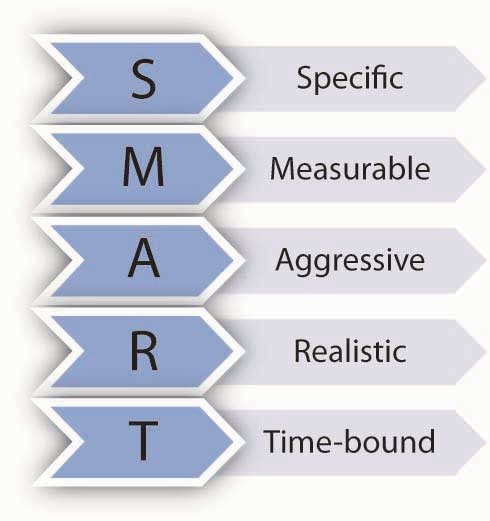
Accumulating research evidence indicates that effective goals are SMART. A SMART goal is a goal that is specific, measurable, aggressive, realistic, and time-bound.
Specific and Measurable
Effective goals are specific and measurable. For example, “increasing sales to a region by 10%” is a specific goal, whereas deciding to “delight customers” is not specific or measurable. When goals are specific, performance tends to be higher (Tubbs, 1986). Why? If goals are not specific and measurable, how would you know whether you have reached the goal? A wide distribution of performance levels could potentially be acceptable. For the same reason, “doing your best” is not an effective goal, because it is not measurable and does not give you a specific target.
Certain aspects of performance are easier to quantify. For example, it is relatively easy to set specific goals for productivity, sales, number of defects, or turnover rates. However, not everything that is easy to measure should be measured. Moreover, some of the most important elements of someone’s performance may not be easily quantifiable (such as employee or customer satisfaction). So how do you set specific and measurable goals for these soft targets? Even though some effort will be involved, metrics such as satisfaction can and should be quantified. For example, you could design a survey for employees and customers to track satisfaction ratings from year to year.
Aggressive
This may sound counterintuitive, but effective goals are difficult, not easy. Aggressive goals are also called stretch goals. According to a Hay Group study, one factor that distinguishes companies that are ranked as “Most Admired Companies” in Fortune magazine is that they set more difficult goals (Stein, 2000). People with difficult goals outperform those with easier goals (Mento, Steel, & Karren, 1987; Phillips & Gully, 1997; Tubbs, 1986; Yukl & Latham, 1978). Why? Easy goals do not provide a challenge. When goals are aggressive and require people to work harder or smarter, performance tends to be dramatically higher. Research shows that people who have a high level of self-efficacy and people who have a high need for achievement tend to set more difficult goals for themselves (Phillips & Gully, 1997).
Realistic
While goals should be difficult, they should also be based in reality. In other words, if a goal is viewed as impossible to reach, it will not have any motivational value. In fact, setting impossible goals and then punishing people for not reaching these goals is cruel and will demotivate employees.
Time-Bound
The goal should contain a statement regarding when the proposed performance level will be reached. For example, “increasing sales to a region by 10%” is not a time-bound goal, because there is no time limit. Adding a limiter such as “by December of the current fiscal year” gives employees a sense of time urgency.
Here is a sample SMART goal: Wal-Mart Stores Inc recently set a goal to eliminate 25% of the solid waste from U.S. stores by the year 2009. This goal meets all the conditions of being SMART (as long as 25% is a difficult yet realistic goal) (Heath & Heath, 2008). Even though it seems like a simple concept, in reality many goals that are set within organizations may not be SMART. For example, Microsoft recently conducted an audit of its goal setting and performance review system and found that only about 40% of the goals were specific and measurable (Shaw, 2004).
Ensuring Goal Alignment Through Management by Objectives (MBO)
Goals direct employee attention toward a common end. Therefore, it is crucial for individual goals to support team goals and team goals to support company goals. A systematic approach to ensure that individual and organizational goals are aligned is Management by Objectives (MBO). First suggested by Peter Drucker (Greenwood, 1981; Muczyk & Reimann, 1989; Reif & Bassford, 1975), MBO involves the following process:
- Setting company-wide goals derived from corporate strategy
- Determining team- and department-level goals
- Collaboratively setting individual-level goals that are aligned with corporate strategy
- Developing an action plan
- Periodically reviewing performance and revising goals
A review of the literature shows that 68 out of the 70 studies conducted on this topic displayed performance gains as a result of MBO implementation (Rodgers & Hunter, 1991). It also seems that top management commitment to the process is the key to successful implementation of MBO programs (Rodgers, Hunter, & Rogers, 1993). Even though formal MBO programs have fallen out of favor since the 1980s, the idea of linking employee goals to corporate-wide goals is a powerful idea that benefits organizations.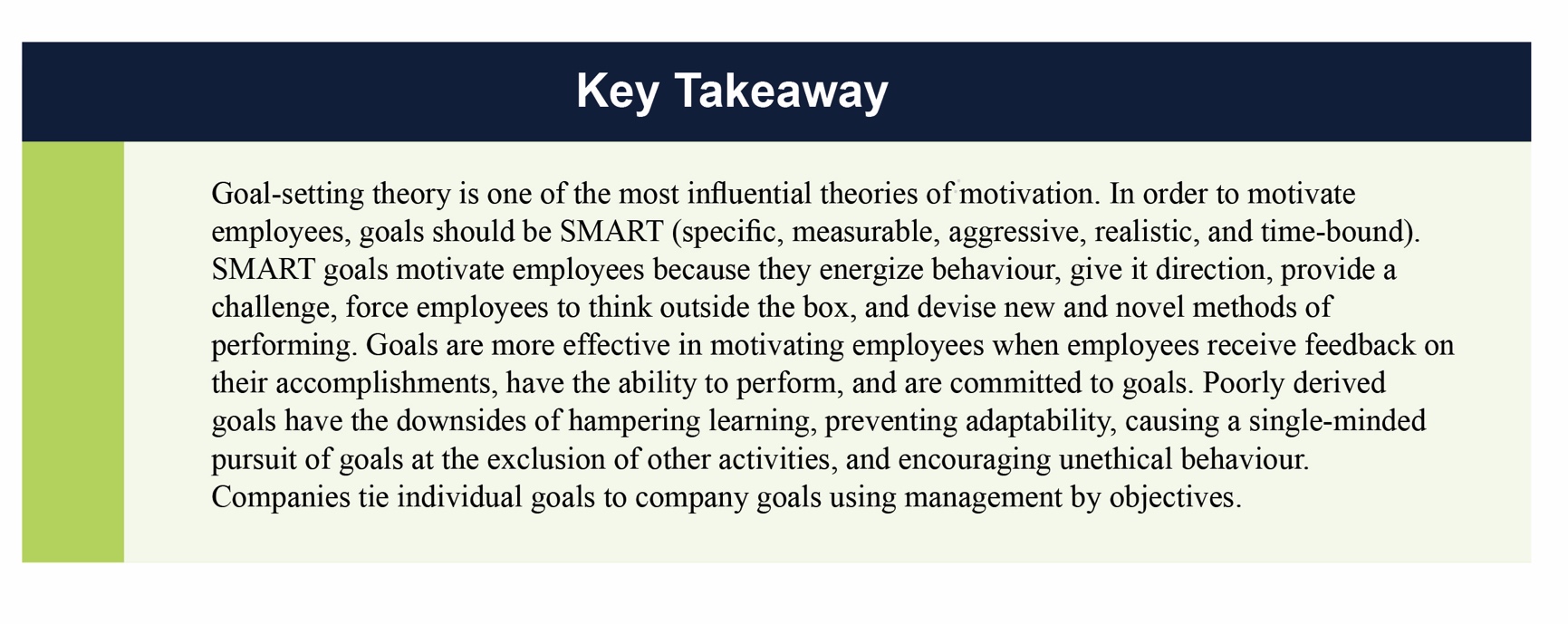
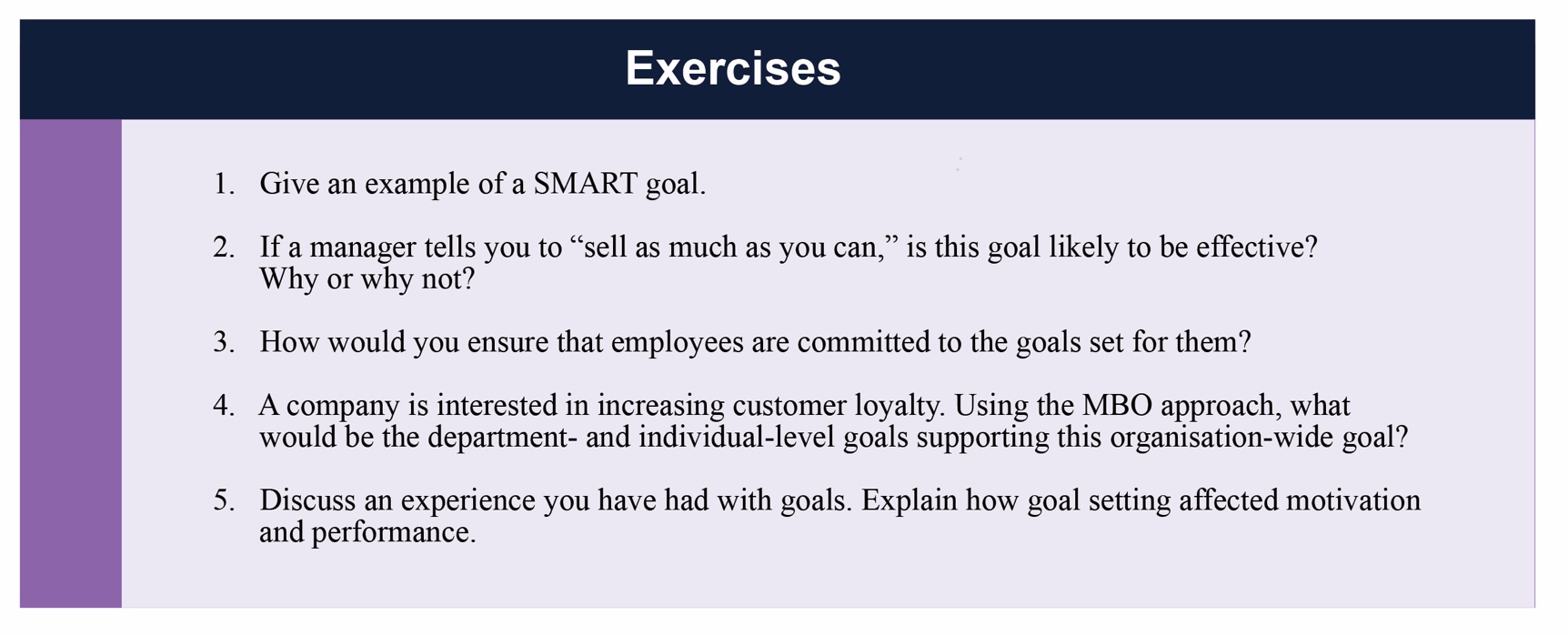
6.4 Motivating Employees Through Performance Incentives
Performance Incentives
Perhaps the most tangible way in which companies put motivation theories into action is by instituting incentive systems. Incentives are reward systems that tie pay to performance. There are many incentives used by companies, some tying pay to individual performance and some to company-wide performance. Pay-for-performance plans are very common among organizations. For example, according to one estimate, 80% of all American companies have merit pay, and the majority of Fortune 1000 companies use incentives (Luthans & Stajkovic, 1999). Using incentives to increase performance is a very old idea. For example, Napoleon promised 12,000 francs to whoever found a way to preserve food for the army. The winner of the prize was Nicolas Appert, who developed a method of canning food (Vision quest, 2008). Research shows that companies using pay-for-performance systems actually achieve higher productivity, profits, and customer service. These systems are more effective than praise or recognition in increasing retention of higher performing employees by creating higher levels of commitment to the company (Cadsby, Song, & Tapon, 2007; Peterson & Luthans, 2006; Salamin & Hom, 2005). Moreover, employees report higher levels of pay satisfaction under pay-for-performance systems (Heneman, Greenberger, & Strasser, 1988).
At the same time, many downsides of incentives exist. For example, it has been argued that incentives may create a risk-averse environment that diminishes creativity. This may happen if employees are rewarded for doing things in a certain way, and taking risks may negatively affect their paycheck. Moreover, research shows that incentives tend to focus employee energy to goal-directed efforts, and behaviours such as helping team members or being a good citizen of the company may be neglected (Breen, 2004; Deckop, Mengel, & Cirka, 1999; Wright et al., 1993). Despite their limitations, financial incentives may be considered powerful motivators if they are used properly and if they are aligned with company-wide objectives. The most frequently used incentives are listed as follows.
Piece Rate Systems
Under piece rate incentives, employees are paid on the basis of individual output they produce. For example, a manufacturer may pay employees based on the number of purses sewn or number of doors installed in a day. In the agricultural sector, fruit pickers are often paid based on the amount of fruit they pick. These systems are suitable when employee output is easily observable or quantifiable and when output is directly correlated with employee effort. Piece rate systems are also used in white-collar jobs such as check-proofing in banks. These plans may encourage employees to work very fast, but may also increase the number of errors made. Therefore, rewarding employee performance minus errors might be more effective. Today, increases in employee monitoring technology are making it possible to correctly measure and observe individual output.
Individual Bonuses
Bonuses are one-time rewards that follow specific accomplishments of employees. For example, an employee who reaches the quarterly goals set for her may be rewarded with a lump sum bonus. Employee motivation resulting from a bonus is generally related to the degree of advanced knowledge regarding bonus specifics.
Merit Pay
In contrast to bonuses, merit pay involves giving employees a permanent pay raise based on past performance. Often the company’s performance appraisal system is used to determine performance levels and the employees are awarded a raise, such as a 2% increase in pay. One potential problem with merit pay is that employees come to expect pay increases. In companies that give annual merit raises without a different raise for increases in cost of living, merit pay ends up serving as a cost-of-living adjustment and creates a sense of entitlement on the part of employees, with even low performers expecting them. Thus, making merit pay more effective depends on making it truly dependent on performance and designing a relatively objective appraisal system.
Sales Commissions
In many companies, the paycheck of sales employees is a combination of a base salary and commissions. Sales commissions involve rewarding sales employees with a percentage of sales volume or profits generated. Sales commissions should be designed carefully to be consistent with company objectives. For example, employees who are heavily rewarded with commissions may neglect customers who have a low probability of making a quick purchase. If only sales volume (as opposed to profitability) is rewarded, employees may start discounting merchandise too heavily, or start neglecting existing customers who require a lot of attention (Sales incentive plans, 2006). Therefore, the blend of straight salary and commissions needs to be managed carefully.
Awards
Some companies manage to create effective incentive systems on a small budget while downplaying the importance of large bonuses. It is possible to motivate employees through awards, plaques, or other symbolic methods of recognition to the degree these methods convey sincere appreciation for employee contributions. For example, Yum! Brands Inc, the parent company of brands such as KFC and Pizza Hut, recognizes employees who go above and beyond job expectations through creative awards such as the seat belt award (a seat belt on a plaque), symbolizing the roller-coaster-like, fast-moving nature of the industry. Other awards include things such as a plush toy shaped like a jalapeño pepper.
Team Bonuses
In situations in which employees should cooperate with each other and isolating employee performance is more difficult, companies are increasingly resorting to tying employee pay to team performance.
Gainsharing
Gainsharing is a company-wide program in which employees are rewarded for performance gains compared to past performance. These gains may take the form of reducing labor costs compared to estimates or reducing overall costs compared to past years’ figures. These improvements are achieved through employee suggestions and participation in management through employee committees.
Profit Sharing
Profit sharing programs involve sharing a percentage of company profits with all employees. These programs are company-wide incentives and are not very effective in tying employee pay to individual effort, because each employee will have a limited role in influencing company profitability. At the same time, these programs may be more effective in creating loyalty and commitment to the company by recognizing all employees for their contributions throughout the year.
Stock Options
A stock option gives an employee the right, but not the obligation, to purchase company stocks at a predetermined price. For example, a company would commit to sell company stock to employees or managers 2 years in the future at $30 per share. If the company’s actual stock price in 2 years is $60, employees would make a profit by exercising their options at $30 and then selling them in the stock market. The purpose of stock options is to align company and employee interests by making employees owners. However, options are not very useful for this purpose, because employees tend to sell the stock instead of holding onto it. In the past, options were given to a wide variety of employees, including CEOs, high performers, and in some companies all employees. For example, Starbucks Corporation was among companies that offered stock to a large number of associates. Options remain popular in start-up companies that find it difficult to offer competitive salaries to employees. In fact, many employees in high-tech companies such as Microsoft and Cisco Systems Inc became millionaires by cashing in stock options after these companies went public. In recent years, stock option use has declined. One reason for this is the changes in options accounting.
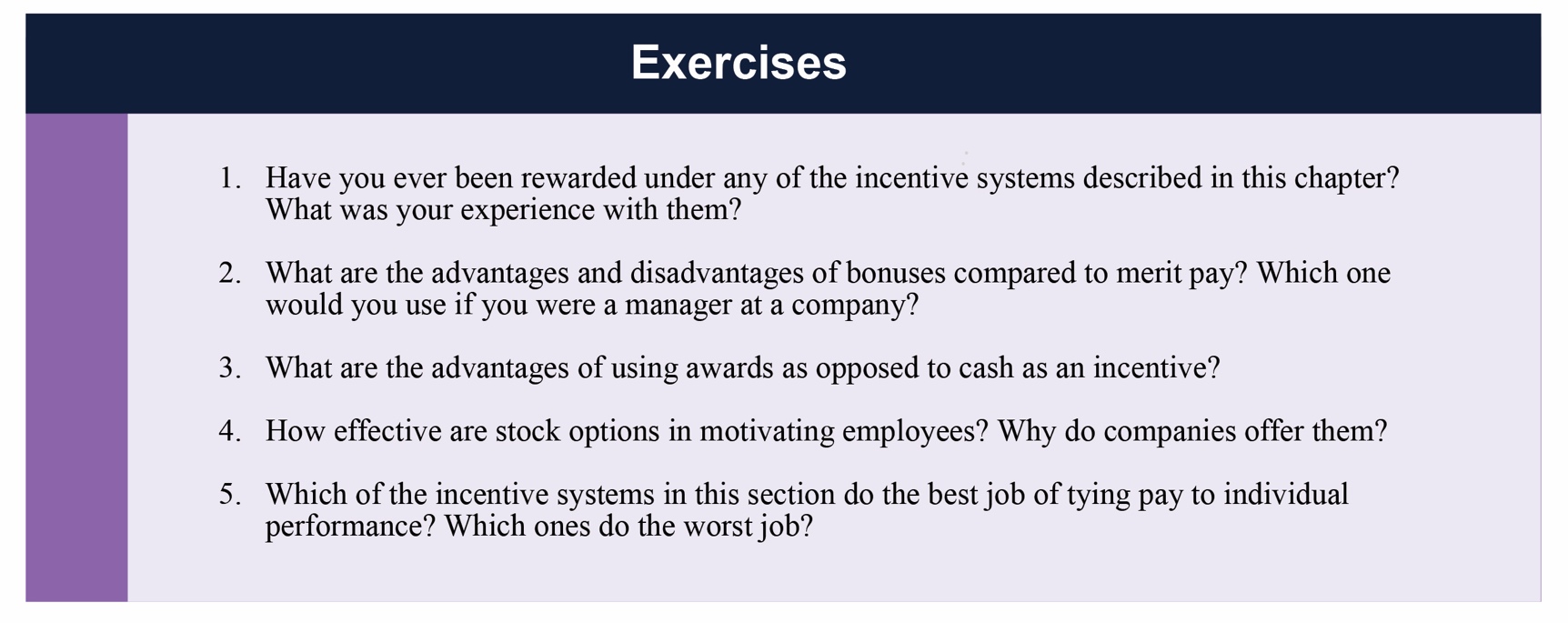

Motivating Neurodiverse Individuals
To encourage sustainable growth, many bet performing companies are looking to identify new talent and have found that neurodiverse individuals — those with autism, Asperger’s syndrome, dyslexia, attention deficit hyperactivity disorder, and dyspraxia — can create innovation and contribute to the skills needed for emerging areas such as artificial intelligence, automation, blockchain, cybersecurity and data management (Twaronite, 2020). Over 15% of the Canadian workforce is neurodiverse, and leveraging the unique capabilities of these employees is becoming a competitive advantage among organizations (Bitti, 2022). Some researchers claim that “Neurodiversity is a moral, social, and economic imperative; everybody loses when human potential is squandered” (Doyle, 2021, p. 194). Leveraging the unique talents of neurodiverse individuals involves having an environment that inspires and motivates them. In a seminal article by Szulc, Davies, Tomczak, & McGregor (2021) researched how best to motivate neurodiverse individuals in a remote workplace environment. They make several recommendations drawing on the ability, motivation, and opportunity (AMO) model and an emerging strength-based approach to neurodiversity. Her recommendations are summarized below:

Szulc, Davies, Tomczak, & McGregor (2021) concluded that in order best to leverage the skills and capabilities of not only neurodiverse individuals but all individuals working remotely while enhancing their motivation, organizations should:
- Offer flexible hours of work
- Set up support groups as platforms for questions and feedback and as a place to share strategies for remote work.
- Ask proactively about accommodations needed.
- Introduce and support mentoring and coaching (e.g., team buddies, job coaches)
6.5 Motivation Key for Success: The Case of Xerox
As of 2010, Xerox Corporation (NYSE: XRX) is a $22 billion, multinational company founded in 1906 and operating in 160 countries. Xerox is headquartered in Norwalk, Connecticut, and employs 130,000 people. How does a company of such size and magnitude effectively manage and motivate employees from diverse backgrounds and experiences? Such companies depend on the productivity and performance of their employees. In their journey over the last 100 years, they’ve withstood many successes and failures. In 2000, Xerox was facing bankruptcy after years of mismanagement, piles of debt, and mounting questions about its accounting practices.
Anne Mulcahy turned Xerox around. Mulcahy joined Xerox as an employee in 1976 and moved up the corporate ladder, holding several management positions until she became CEO in 2001.
In 2005, Mulcahy was named by Fortune magazine as the second most powerful woman in business. Based on a lifetime of experience with Xerox, she knew that the company had powerful employees who were not motivated when she took over. Mulcahy believed that among other key business changes, motivating employees at Xerox was a key way to pull the company back from the brink of failure. One of her guiding principles was a belief that in order to achieve customer satisfaction, employees must be interested and motivated in their work. Mulcahy not only successfully saw the company through this difficult time but also was able to create a stronger and more focused company.

In 2009, Mulcahy became the chairman of Xerox’s board of directors and passed the torch to Ursula Burns, who became the new CEO of Xerox. Burns became not only the first African American woman CEO to head a Standard & Poor’s (S&P) company but also the first woman to succeed another woman as the head of an S&P 100 company. Burns is also a lifetime Xerox employee who has been with the company for over 30 years.
She began as a graduate intern and was hired full-time after graduation. Because of her tenure with Xerox, she has close relationships with many of the employees, which provides a level of comfort and teamwork. She describes Xerox as a nice family. She maintains that Mulcahy created a strong and successful business but encouraged individuals to speak their mind, to not worry about hurting one another’s feelings, and to be more critical.
Burns explains that she learned early on in her career, from her mentors at Xerox, the importance of managing individuals in different ways and not intentionally intimidating people but rather relating to them and their individual perspectives. As CEO, she wants to encourage people to get things done, take risks, and not be afraid of those risks. She motivates her teams by letting them know what her intentions and priorities are. The correlation between a manager’s leadership style and the productivity and motivation of employees is apparent at Xerox. Employees feel a sense of importance and a part of the process which are necessary to maintain a successful and profitable business. In 2010, Anne Mulcahy retired from her position on the board of directors to pursue new projects (Anne, 2010; Bryant, 2010; 50 most powerful women, 2006; Tompkins, 1992; Whitney, 2010).
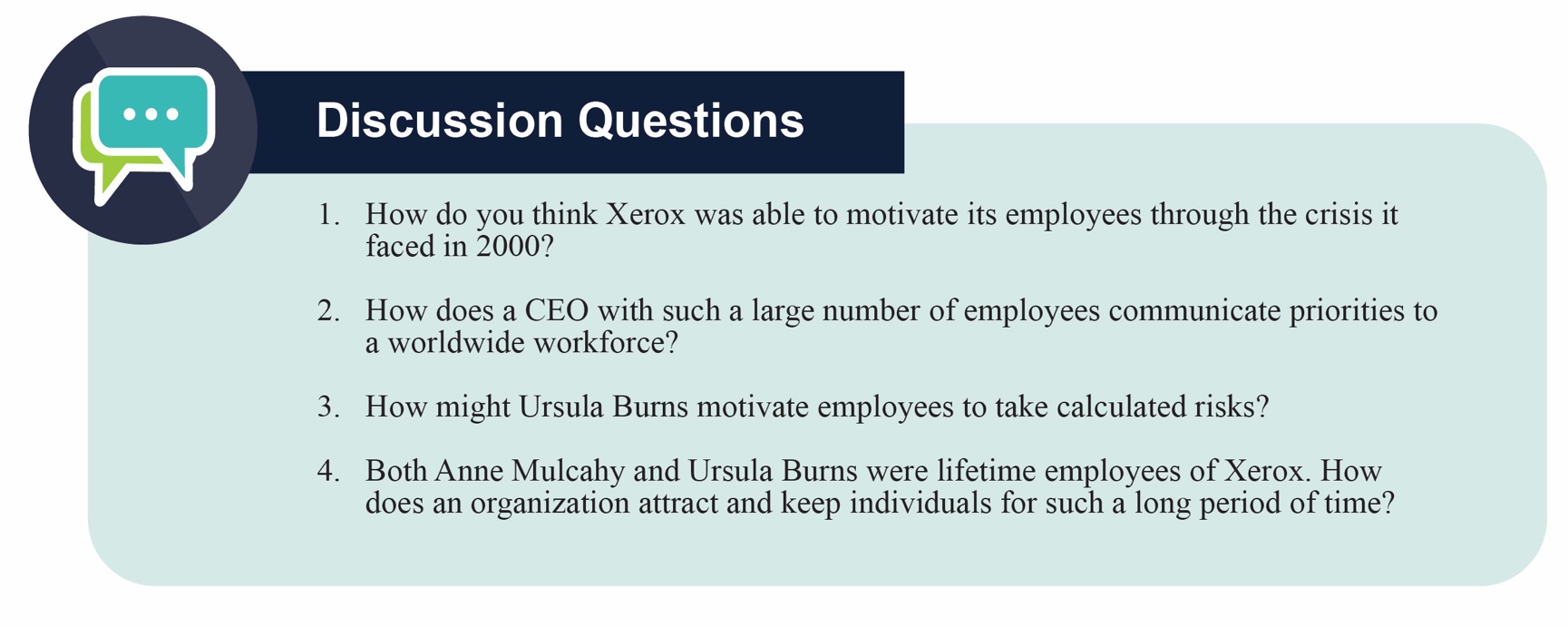 6.6 Conclusion
6.6 Conclusion
In this chapter, we reviewed specific methods with which companies attempt to motivate their workforce. Designing jobs to increase their motivating potential; to empower employees; to set goals; to evaluate performance; to offer performance appraisals; and tying employee pay to individual, group, or organizational performance using incentive systems are methods through which motivation theories are put into action. Even though these methods seem to have advantages, every method could have unintended consequences, and therefore, application of each method should be planned and executed with an eye for organizational fairness.

